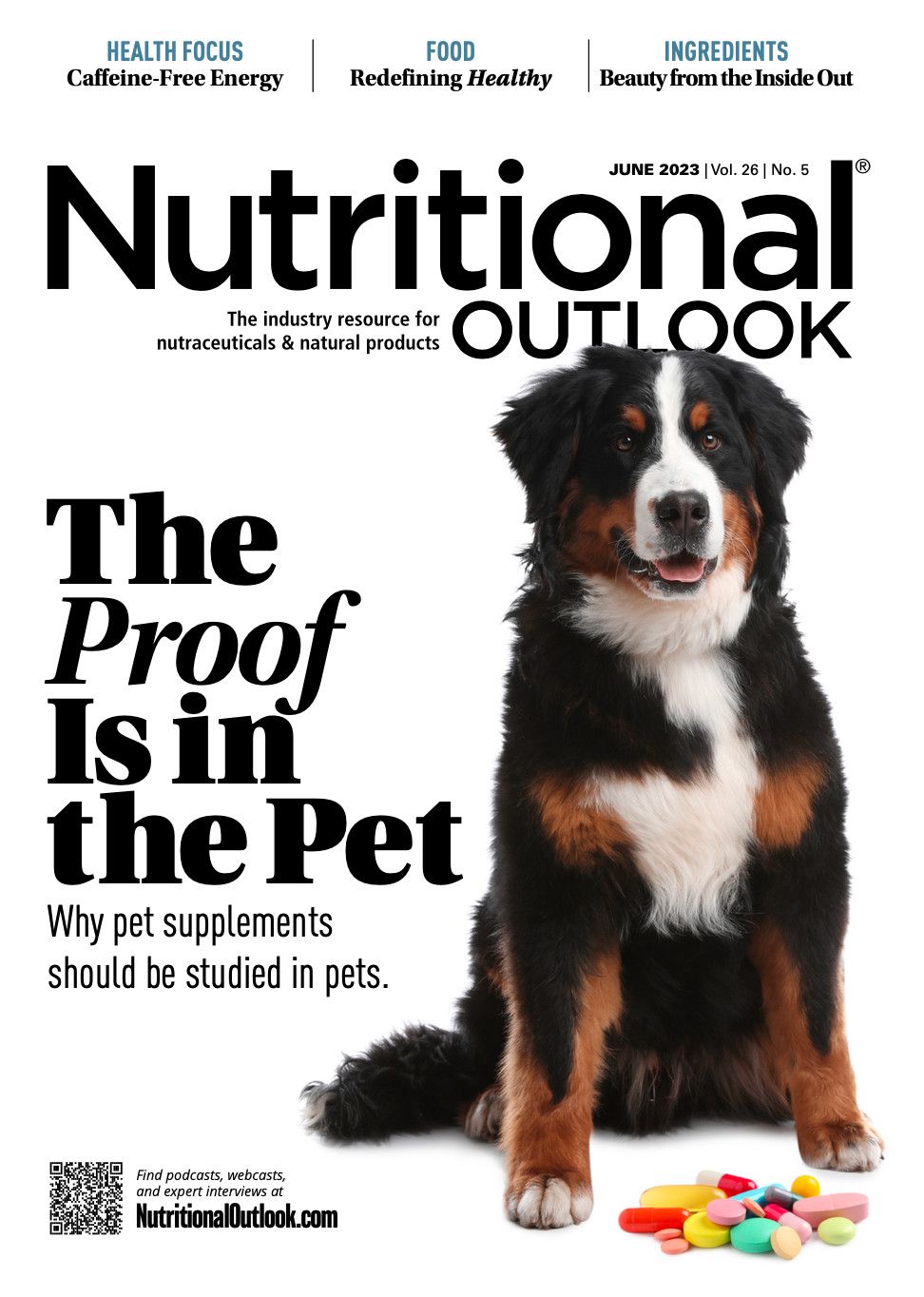Nutricosmetic experts discuss trends driving the beauty-from-within market
There’s still a lot of white space in the beauty-from-within market. Experts point out the future opportunities.
© Puhhha / Stock.adobe.com

In this day and age, one hopes that consumers understand that when Rod Stewart sang “Forever Young,” he wasn’t talking about finding the fountain of youth.
It’s commendable that the dietary supplement industry has been in the camp of aging gracefully for quite a while now rather than denying that aging actually exists.
According to Catherine Kwik-Uribe, PhD, Nutrition21’s (Harrison, NY) vice president of scientific and regulatory affairs, “Consumers are well aware [of the role] that good nutrition plays in their overall health, and in recent years, this awareness has extended to recognition that specific foods and supplements can play a key role in the look and health of their skin and hair.”
Kwik-Uribe believes that “this is particularly important when gaps in the diet—things like stress, motherhood, and general aging—affect how skin and hair can look and feel. As a result, we are seeing that consumers are increasingly interested in finding dietary approaches, including supplements, that can offer trusted solutions that can make them feel and look their best.”
Andrea Zangara, head of scientific communication and medical affairs at Euromed (Mollet del Vallès, Spain), finds that aging and associated skin changes are motivators for consumers to “seek out nutritional solutions to improve the appearance of their skin, recognizing that it reflects their age and overall health. As consumers become better educated about the correlation between skin health and nutrition, they understand how nutricosmetics work from within.”
As Paula Simpson, BSc in nutritional sciences, RNCP, R. Herbalist, founder of Nutribloom, sees it, “Clinical research on nutricosmetics has steadily grown over the last 20 years. What started with ingredients, then moving to finished products, the quality of evidence and clinical design has improved.” She says this “has helped identify the unique chemical properties and mechanism of action of how ingredients or finished products work within.”
Kwik-Uribe says that for decades, “beauty-from-within has been based on a handful of common/conventional nutrients—vitamin C, omega-3 fatty acids, vitamin E, biotin—marketed with hair, skin, and nail benefits.” However, Kwik-Uribe is pleased that the category is evolving. She explains that “rather than repackaging the same nutrients, innovation is needed.” She counts Nutrition21 among those innovators, with its 2021 introduction of Lustriva, which delivers novel forms of biotin and silicon into this growing market.
Zangara sees strong opportunities for botanical extracts, too, especially given the growing interest in plant-based products. He calls this market development “not surprising, given the fact that botanical compounds are regarded as a health-supporting gift from Mother Nature.”
The Holistic Approach Paves a Path Forward
It’s not only the ingredients themselves that are expanding; it’s the broader approach to how companies—and consumers—are increasingly viewing the beauty category. As with other categories in the supplement industry, beauty-from-within ingredient suppliers and product manufacturers are taking a holistic approach to bringing new ingredients to market—and to marketing itself. Whether you call it “nutricosmetics” or “nutribeauty,” and categorize it as “beauty from the inside out” or “beauty from within,” it’s the understanding that what’s at its heart is this: how healthy we are can have an impact on how healthy we look and feel.
“The positive is that the beauty-from-within category has gained attention from consumers as they search for more-holistic solutions to health and wellness,” states Lauren Eisen, PMP, marketing and business development manager for minerals and nutrients at Balchem Corp. (New Hampton, NY). Now under the Balchem banner, what was formerly Bergstrom Nutrition’s branded ingredient, OptiMSM methylsulfonylmethane (MSM), provides a source of sulfur, supporting skin’s structural framework, appearance, and condition, as well as maintaining healthy hair, she says.
“Evidence for MSM’s benefits for skin and hair health have existed for years,” Eisen says. “As millennials and baby boomers are aging, they are not only looking to improve their appearance topically but also improve overall skin health from inside out for healthy aging.”
The focus in this space, agrees Alice Olufeso, senior product manager, food and health, Europe, at Mibelle Biochemistry (Buchs, Switzerland), lies in beauty-from-within products. The fact is, however, that there are so many other directions possible—including in the antiaging space, for example. “Here, we not only talk about the skin but also other aging-related topics such as memory and cognitive function, slow metabolism, or hair loss,” she adds.
Mibelle counts among its branded ingredients for nutraceuticals, food supplements, and functional foods FenuKale Nu and DracoBelle Nu, both of which work for beauty-from-within and healthy-aging applications, given their science-based parameters of skin protection and improvement.
Verdure Sciences (Noblesville, IN) reminds us that it’s not just the ingredients that add luster to hair, strength to nails, or suppleness to skin that constitute what the shifting beauty business is—or can be—all about. “Beauty is a uniquely broad well-being category,” says Antonio King, digital marketing specialist at Verdure Sciences, “and with this lies the ability to offer tangible health benefits through a vast number of avenues.”
In other words, it’s figuring out the extension of which ingredients and benefits impact beauty overall, and then shifting marketing messages. For example, while Verdure’s branded pomegranate extract ingredient, Pomella, may be thought of first for its beauty-from-within benefits because of its positive impact on skin, for starters, King wants us to also look at “the range of applications for beauty,” including the “restful and restorative sleep and alertness upon waking” benefits of another Verdure ingredient, Bacognize (Bacopa monnieri). And King is bringing receipts. He shares that a recent study on Bacognize suggests that the proprietary ingredient “supports the opportunity to promote restful, restorative, and rejuvenating sleep, allowing individuals to wake up feeling refreshed and energized without feeling groggy or tired when waking up.”1
So, when your mother told you to get your beauty sleep, she wasn’t wrong, because, truth be told, who among us doesn’t feel—and look—more beautiful after a restful night?
Euromed’s Zangara takes it a step further, advising that “the concept of beauty has evolved to encompass a holistic approach that connects beauty with overall health and well-being. Nutricosmetics, or beauty-from-within products, emphasize the interconnection between beauty and health.” He claims that “one example is the relationship between cardiovascular health and beauty, as proper blood circulation promotes healthy skin, hair, and nails.”
Stress, too, says Zangara, “can accelerate aging and affect our appearance, highlighting the need for stress-management techniques. And the gut microbiome influences skin health, emphasizing the importance of a healthy gut through diet and probiotics.”
Antonio Vendrell, marketing director for Bioiberica (Barcelona, Spain), ties the nutribeauty category’s exponential growth in recent years to how increasingly aware consumers are of how traditional beauty is linked to their holistic well-being and health.
The Four Ss for Success: Synergy, Science, Substantiation, and Safety
Simpson says, “When we consume a food, it is the synergy of nutrients that work together to support our health. For nutricosmetics, targeted ingredients can work in the same manner.” And, she advises, that “through establishing a better understanding via clinical research, we can identify how nutricosmetics work differently over topical care alone.”
Mibelle Biochemistry manufactures branded ingredients for nutricosmetics and cosmeceuticals. And Olufeso shares that “we see greater opportunities in nutricosmetics.” Here’s why: “The cosmeceutical space is already very well established, with many innovative products out there, as we have seen over the past 30 years.” However, she advises that the nutricosmetic beauty-from-within trend has only begun more recently and still has many possible prospects.
Kwik-Uribe points to another important synergy consideration—one in which, she says, “nutricosmetics help consumers harness a holistic approach to skincare, where they value both what they put on their skin as well as what they ingest. This complementary approach has been embraced increasingly by innovative supplement companies who are looking for ingredients that are not just thought to improve skin health but that have actually been shown in clinical studies to provide significant benefits to hair, skin, and nail health.”
In other words, science matters. And, so does substantiation.
Zangara believes that “as consumers become more interested in understanding how nutrients work within their bodies, they will favor products supported by the greatest amount of scientific research and substantiation.”
Vendrell, too, says, “We believe that science is driving the beauty-from-within category forward as brands seek to differentiate themselves in an increasingly competitive marketplace.” He points to Mintel market research data from 2022 on the UK women’s facial skincare market which found that 50% of consumers seek proven ingredients when purchasing a beauty product, showing how crucial scientific claims and substantiation are to product development and positioning these days. Vendrell says that when Bioiberica was developing its branded ingredient Dermial, described as “the first hyaluronic acid matrix ingredient for skin and beauty,” having a science-backed product was important to the company.
Eisen says that both the industry and consumers are looking for substantiation to support new products in the beauty-from-within category, which, she adds, is driving awareness of the need to rely on science when formulating and packaging products.
Plus, Olufeso says, “In nutricosmetics, safety is a big thing. There are many ingredients and products out there with insufficient safety data. With the constant flow of new ingredients and products being launched into this market, it has become more difficult to understand which products are significantly [effective]. Here, clinical study data will help to distinguish and gain the trust of consumers.” Basically, she says, “it is important to provide these data.”
Growth Through Inclusivity
New research also opens doors to new audiences. As Simpson explains, “Nutricosmetics used to be solely marketed to a narrow demographic, whereas today the opportunity for ‘inclusive beauty’ provides an opportunity for growth for different ages, genders, lifestyles, and environments in which we live. If suppliers and manufacturers understand their clientele and target market for brands, they will naturally evolve with the market trends.”
Many companies track those trends and are happy to adapt.
Vendrell notes that the nutricosmetic consumer has changed. “Traditionally, older women represented the conventional consumer in the beauty and emerging nutricosmetic markets,” he says. “However, younger demographics and men are entering the playing field, too, significantly expanding the potential consumer base of these products.”
From Olufeso’s perspective, “Nutricosmetics are primarily taken by 30+ consumers. But we see some changes there.” For instance, she says, consumers in the 15-30 age group are especially now showing more interest in nutricosmetics, signaling new opportunities for industry. “This trend will require…actives and products [to be] more tailored to the needs of this age group,” she points out. “To reach them, it is also important to use the right media channels, such as TikTok or Instagram.”
That said, Zangara doesn’t advise counting out the original age-related demographic for the category, pointing to statistics from the World Health Organization that, he says, show that two billion people are expected to be older than 60 by 2050.
Verdure’s King says that “we have seen this category appeal to an aging audience that is aiming to stay healthy and proactive, and beauty is an area that these consumers are considerably honing in on.”
Another reason to address all age groups is that consumers of different ages have different skin health needs, Zangara adds. “For instance, most women over 40 like to focus on healthy aging and repairing sun damage, while those in their 30s may seek preventative measures,” he explains. As for those under 25, often they are more concerned about reducing blemishes and finding a balance between oily and dry skin, Zangara adds.
But Zangara suggests that no matter the age, the commonality “is the desire for scientific proof.” And, fortunately, he adds, “with more thoroughly researched ingredients being used in beauty-from-within products than ever before, the industry is well on the way to meeting this demand.”
Furthermore, when it comes to the environments in which we live, companies like Mibelle and Nutrition21 are clearly paying attention to the consumer desire for ingredients that have scientific support to demonstrate pollution protection for the skin.
And no one should forget to think about the environmentalists. Zangara advocates that “consumers are also increasingly favoring applications with an ecological and sustainable added value.”
There’s movement in delivery methods, too, in the nutricosmetic category, making sure everyone who wants to take these oral options has a preferred way to do so. For instance, King advises that “we have seen tremendous growth in various delivery methods over the past years, ranging from functional foods and beverages like beauty drinks, chews, and bars to traditional methods like capsules, softgels, and powders. Gummies are also becoming increasingly prominent within the beauty space. These delivery methods can be attributed to the rise in innovation. They open the possibility to add product line diversity, and bring a lot to market.”
Olufeso views the future for delivery methods in more food types of formats. “Today the market is mainly dominated by capsules and tablets,” she says, but food delivery methods, such as gummies, “have gained much popularity in the last two to three years.” She expects this trend toward food-like products in this space will “extend to other formats, adapted to today’s lifestyle” and consumer expectations of taste and convenience. Even formats like chewing gum, direct-consumable powder sticks, or powder beverages may gain market space, she says.
As for the ingredients themselves, Simpson says that “brands can now choose their ingredients based on the category or the demographic they’re targeting.” Whether it’s clinical nutraceutical ingredients, the biotics (pre-, pro-, or postbiotics), or plant medicines, there are more options available today than ever before.
She says that ingredients and science are advancing within nutricosmetics, and she’s particularly intrigued by growing research on the microbiome, longevity/mitochondrial aging, and lifestyle influences (e.g., mood, beauty/stress) on our aesthetic wellness. “It will be interesting to see how these categories emerge in the future,” she says.
What’s more, in thinking about what’s needed for companies to make their ingredients household names, she sees not just the ingredient but the full package as important. In her role as a formulator, Simpson says that it’s not just the specific ingredient but “rather the quality of ingredients, dosage, and product form used that make a difference in how well a formula will work from the inside out.”
Where Industry Can Improve
There’s also a bit of a conundrum for nutricosmetics, one that doesn’t come as a surprise. The conundrum is this: do consumers understand that the effects of beauty-from-within products may take time to surface and require consistent product use to achieve? Vendrell says that “although a growing number of consumers are aware of the longer-term benefits associated with dietary supplementation, some are still highly focused on quick fixes. Education on nutricosmetic ingredients and their role is key to overcoming this, to ensure the category continues to expand.”
Indeed, says Simpson, in this market, consumers seem to have an easier time accepting ingredients with more visible results. “From a market level, fortifying ingredients such as collagen peptides, MSM, or biotin have been popular in North America, I believe, mainly due to the noticeable changes in hair and nails that are seen more quickly over taking an antioxidant, for example. Although all are effective in nurturing our aesthetic wellness, it is the tangible effect that tends to win over the consumer.”
Another challenge? “Consumers also might not realize that fortifying, protecting, or rebalancing the health and appearance of skin, hair, or nails really depends on the biochemical individuality, lifestyle, age, and health of an individual, as these factors determine the most suitable ingredients or formulations to use,” she adds.
“Consumer awareness, more generally, has been a barrier to growth,” agrees Vendrell. Collagen, hyaluronic acid, vitamins C and E, and probiotics are nutraceutical ingredients recognizable to consumers, he observes, “but there is still some work to do to shift existing mindsets so that nutricosmetics become part of the norm for beauty regimens.”
There are other challenges, too, that could stunt market growth, issues that are not unique to this category.
For starters, Zangara points to adulteration, which he says “has become a more important concern than ever, with counterfeit materials entering the supply chain. For example, adulteration remains a key hindrance to pomegranate reaching its full market potential, in spite of the mounting evidence supporting pomegranate’s health benefits. The prevalence of adulterated pomegranate extracts, which do not contain the natural profile of polyphenols found in pomegranate, is a real concern for the industry.”
Therefore, he suggests that “proper testing, strict quality protocols, and a vertically integrated supply chain are of vital importance. Each step—starting with the raw materials—should be traceable, accountable, and transparent.”
Along those lines, Olufeso shares that truthful declaration of actives is another concern. One example she provides is products labeled as “vegan collagen,” which she says doesn’t exist. She insists that “there is no natural source of collagen, as it only can be found in animals. Some products contain amino acids, the building blocks for the collagen structure, but they cannot be named as vegan collagen.”
Vendrell is also wary that regulatory challenges could hinder future category growth. He says that “currently, beauty claims do not fall under the regulatory frameworks for food supplements, meaning that there are numerous products on shelves without science-backed benefit claims. This generates false expectations and ineffective solutions, potentially damaging consumer perception of the category.”
King agrees, as he believes that substantiation is crucial to support the claims made on products, not only from an efficacy perspective but from a transparency perspective, to educate consumers on the claims associated with the products they are buying.
Zangara, too, would like to see more accountability to protect people who want to buy products that deliver what those products promise. People demand more transparency with regards to how and where the products are produced. He adds that “increasing transparency to meet evolving ethical, environmental, and clean-label demands should be key to companies.”
Still, stakeholders are optimistic. Vendrell sums it up: “More and more, individuals acknowledge the power of inner health on outer appearance, and the focus is fast moving away from short-term fixes to long-term solutions. Consumers are increasingly aware that all aspects of health are intrinsically connected.”
In other words, the future of the nutricosmetics market looks very attractive indeed.
Science Sidebar: Skin and Hair Health
Blue Fenugreek Kale Extract
A 2022 study evaluated the effect of Mibelle Biochemistry’s (Buchs, Switzerland) blue fenugreek kale extract, FenuKale Nu, on skin aging. The randomized, double-blind, placebo-controlled clinical trial was conducted in a highly polluted area and studied 59 participants over 56 days. The major parameter studied was skin barrier dysfunction through the assessment of transepidermal water loss. Other study parameters included participant self-assessment of skin conditions such as skin sagging, elasticity, and wrinkle severity.2
The study found that in the intervention group, by the end of the treatment period, the transepidermal water loss level reduced significantly and, at the same time, skin moisture content levels increased. Further, FenuKale Nu significantly reduced protein carbonylation in human dermal fibroblasts stressed with urban pollution. There were no significant changes observed in some of the other study responses, including to questions about wrinkle severity, skin sagging, or elasticity; however, when asked to rate their skin status, such as hydration, luminescence, and texture, the FenuKale Nu participants’ self-assessment score reflected a high satisfactory score level.
FenuKale Nu is ideal for beauty-from-within formulas in the detox, healthy aging, and anti-pollution space, and can be used in a range of applications such as tablets, capsules, beverages, and more, according to the company’s website.
Inositol-Stabilized Arginine Silicate
A randomized, double-blind, 12-week study evaluated the impact of Nutrition21’s (Harrison, NY) branded ingredient Lustriva on hair and skin health. The study included 90 healthy female subjects who self-reported thinning hair. The participants were randomized to one of three groups: 1) high-dose Lustriva, 2) low-dose Lustriva, or 3) placebo.3
Specifically, the results showed a significant increase in hair thickness, measured by change in % vellus hair and % terminal hair and in the ratio of % vellus to terminal hair, in the high-dose Lustriva group compared to the placebo group at week 3. These effects were maintained throughout the study. Although there were no changes in skin elasticity between the groups, the high-dose group had a significant decrease in facial wrinkles at 12 weeks, and after 12 weeks compared to baseline, the high-dose group had significantly improved facial-wrinkle maximum depth, Indentation Index and Score, facial fine lines Indentation Index and Score, and more.
The study participants were ages 21 to 65. The high-dose group was instructed to take one capsule daily of Lustriva, with the active ingredients comprising 146.5 mg of inositol-stabilized arginine silicate, and with 11.7 mg of magnesium biotinate providing 10 mg of silicon and 10 mg of biotin. The low-dose group’s daily capsule consisted of the same amount of inositol-stabilized arginine silicate but only 3.5 mg of magnesium biotinate providing 10 mg of silicon and 3 mg of biotin.
The study authors concluded that high-dose Lustriva supplementation significantly increased hair thickness and reduced facial wrinkle depth compared to placebo and performed better than the low dose in most parameters. They recommended conducting future studies.
Botanical Blend
A randomized, double-blind, placebo-controlled study by researchers from Complife Italia Srl and Monteloeder SL (Madrid, Spain) was published earlier this year to assess the antiaging skin effects and safety of Monteloeder’s branded ingredient Eternalyoung.4
The study results showed that the proprietary blend of four botanical ingredients—pomegranate (Punica granatum), sweet orange (Citrus sinensis), desert ginseng (f. Cistanche), and gotu kola (Centella asiatica)—may positively affect the appearance, barrier function, and skin density of aged skin after 12 weeks of treatment.
The researchers studied a population of 60 Caucasian women, aged 35-69, all of whom exhibited signs of both sun-induced and chronological skin aging—specifically, mild to moderate wrinkles and dark spots. Participants each received a daily dose of a hard gelatin capsule containing either 225 mg of the Eternalyoung complex or a placebo for the length of the study.
According to the study authors, in the Eternalyoung subjects, statistically significant improvements compared to the placebo group were observed as early as 4 weeks into the study regarding wrinkle depth, elasticity, firmness, skin thickness, skin moisturization, transepidermal water loss, and dark spots pigmentation. In addition, the subjects who consumed the botanical blend reported better scores on self-assessment questionnaires. For example, those in the botanical blend group self-reported that their skin felt more “radiant, healthy, and youthful.” Further, the botanical blend visibly and structurally improved the skin and reduced signs of aging, without side effects, the researchers reported.
Pomegranate Extracts
A 2022-published prospective, double-blind, placebo-controlled study in a population of males and females demonstrated improvements in several biophysical properties, wrinkles, and shifts in the skin microbiome after supplementation with Pomella, Verdure Sciences’ (Noblesville, IN) proprietary Punica granatum extract.5
The four-week pilot study included healthy females and males aged 25-55. At the study’s completion, there were 8 subjects in the intervention group (6 female, 2 male) and 10 in the control group (9 female, 1 male). The intervention group received an oral supplement of 250 mg of Pomella pomegranate fruit extract, standardized to 75 mg of punicalagin, once daily over the duration of the study, while the control group received a placebo.
Among the results, the Pomella group showed significant reduction in wrinkle severity (6.2% compared to placebo) and a decreasing trend in forehead sebum excretion rate.
Further, the facial skin microbiome was examined for the Bacillus genus and Staphylococcus epidermidis after Pomella supplementation. The participants in the Pomella group who had a higher relative abundance of Eggerthellaceae in their gut had a decrease in their facial transepidermal water loss and wrinkle severity.
The study authors also performed a sub-analysis among participants in the Pomella group for the gut microbiome expression of Eggerthellaceae. The corresponding study author advised that “our results suggest that the presence of Eggerthellaceae may predict a better response to Pomella supplementation and supports the notion of a gut-skin axis when considering oral supplementation.”
Verdure Sciences funded the research but had no role in the study itself, from design, data analysis, through to publishing decisions. “Further studies with an expanded cohort are warranted,” said the authors. Verdure’s digital marketing specialist, Antonio King, says that in addition to this publication, the company is “awaiting a second publication to accompany the mounting evidence for Pomella pomegranate extract.”
Meanwhile, an in vitro study evaluated the effects of the pomegranate natural extract Pomanox from Euromed S.A. (Mollet del Vallès, Spain). The branded pomegranate fruit extract was studied for skin health–related parameters in normal- and UV-induced photoaging conditions in human fibroblast Hs68 cells. The inhibitory effects of Pomanox on tyrosinase activity were also assessed. The study authors concluded, “The modulation of skin health–related parameters exhibited by Pomanox open a wide range of potential applications of this product.”6
More specifically, under normal conditions, Pomanox significantly increased collagen and hyaluronic acid metabolism. In UV-exposed cells, both preventive and regenerative treatments with Pomanox positively modulated hyaluronic acid metabolism and decreased reactive oxygen species levels. The researchers noted, however, that only the preventive treatment modulated collagen metabolism. Pomanox also showed a marked inhibitory capacity of tyrosinase activity, thus potentially reducing hyperpigmentation by decreasing melanin synthesis.
In response to the published results, Euromed said that “Pomanox may reduce unaesthetic signs of skin aging such as hyperpigmentation, skin dryness, and loss of elasticity by reducing melanogenesis and oxidative stress while modulating collagen and hyaluronic acid metabolism.” The company said that the results from this proof-of-concept in vitro test in human fibroblast cells suggest that Pomanox “is a promising ingredient for nutricosmetic and beauty-from-within applications.” It said it’s now preparing clinical studies to further this research.
Hyaluronic Acid Matrix Ingredient
A peer-reviewed paper7 published earlier this year evaluated Bioiberica’s (Barcelona, Spain) branded hyaluronic acid matrix ingredient, Dermial, at an in vitro level and found antiaging, regenerative, and antioxidant properties in skin cells, according to a company press release. This review further validates the potential of Dermial for use in nutricosmetics, Bioiberica said. Dermial is a hyaluronic acid matrix ingredient with a unique combination of highly concentrated hyaluronic acid (67%) and other glycosaminoglycans (GAGs) such as dermatan sulfate and collagen.
The study authors, including researchers from Bioiberica, stated that overall, the results of this study suggest that Dermial has a variety of potential benefits for the skin, including stimulating cell migration and proliferation; inducing the synthesis of collagen, elastin, and GAGs; and protecting against reactive oxygen species (ROS)-induced DNA damage and ROS production. The researchers added that “these properties may make the HA matrix a useful ingredient in skincare products aimed at improving the appearance of aged skin.”
According to Daniel Martinez Puig, head of human health, research, and development at Bioiberica, in a press release, “Following these promising outcomes, our next steps will be to carry out a clinical trial to confirm the efficacy of Dermial in humans.”
References
- Lopresti, A.L.; Smith, S.J.; Ali, S.; Metse, A.P.; Kalns, J.; Drummond, P.D. Effects of a Bacopa monnieri Extract (Bacognize®) on Stress, Fatigue, Quality of Life and Sleep in Adults with Self-Reported Poor Sleep: A Randomised, Double-Blind, Placebo-Controlled Study. J Funct Foods. 2021, 85, 104671. DOI: 10.1016/j.jff.2021.104671
- Kappler, K.; Grothe, T.; Srivastava, S.; Jagtap, M. Evaluation of the Efficacy and Safety of Blue Fenugreek Kale Extract on Skin Health and Aging, In-vitro and Clinical Evidences. Clin Cosmet Investig Dermatol. Published online September 28, 2022. DOI: 10.2147/CCID.S368576
- Kalman, D.S.; Hewlings, S.J. A Randomized Double-Blind Evaluation of a Novel Biotin and Silicon Ingredient Complex on the Hair and Skin of Healthy Women. J Clin Exp Dermatol Res. 2021, 12 (1). https://www.longdom.org/open-access/a-randomized-doubleblind-evaluation-of-a-novel-biotin-and-silicon-ingredient-complex-on-the-hair-and-skin-of-healthy-wom.pdf
- Nobile, V.; Schiano, I.; Germani, L.; et al. Skin Anti-Aging Efficacy of a Four-Botanical Blend Dietary Ingredient: A Randomized, Double Blind, Clinical Study. Cosmetics. 2023, 10 (1). DOI: 10.3390/cosmetics10010016
- Chakkalakal, M.; Nadora, D.; Gahoonia, N.; et al. Prospective Randomized Double-Blind Placebo-Controlled Study of Oral Pomegranate Extract on Skin Wrinkles, Biophysical Features, and the Gut-Skin Axis. J Clin Med. 2022, (11) 22, 6724. DOI: 10.3390/jcm11226724
- Mariné-Casadó, R.; Teichenné, J.; Tobajas, Y.; et al. Pomegranate Natural Extract Pomanox® Positively Modulates Skin Health-Related Parameters in Normal and UV-Induced Photoaging Conditions in Hs68 Human Fibroblast Cells. Int J Food Sci Nutr. 2023, 74 (1), 51-63. DOI: 10.1080/09637486.2022.2152189
- Galvez-Martin, P.; Soto-Fernandez, C.; Romero-Rueda, J.; et al. A Novel Hyaluronic Acid Matrix Ingredient with Regenerative, Anti-Aging and Antioxidant Capacity. Int J Mol Sci. 2023, 24 (5), 4774. DOI: https://doi.org/10.3390/ijms24054774

Prinova acquires Aplinova to further increase its footprint in Latin America
April 7th 2025Prinova has recently announced the acquisition of Brazilian ingredients distributor Aplinova, which is a provider of specialty ingredients for a range of market segments that include food, beverage, supplements, and personal care.

.png&w=3840&q=75)

.png&w=3840&q=75)



.png&w=3840&q=75)



.png&w=3840&q=75)
















